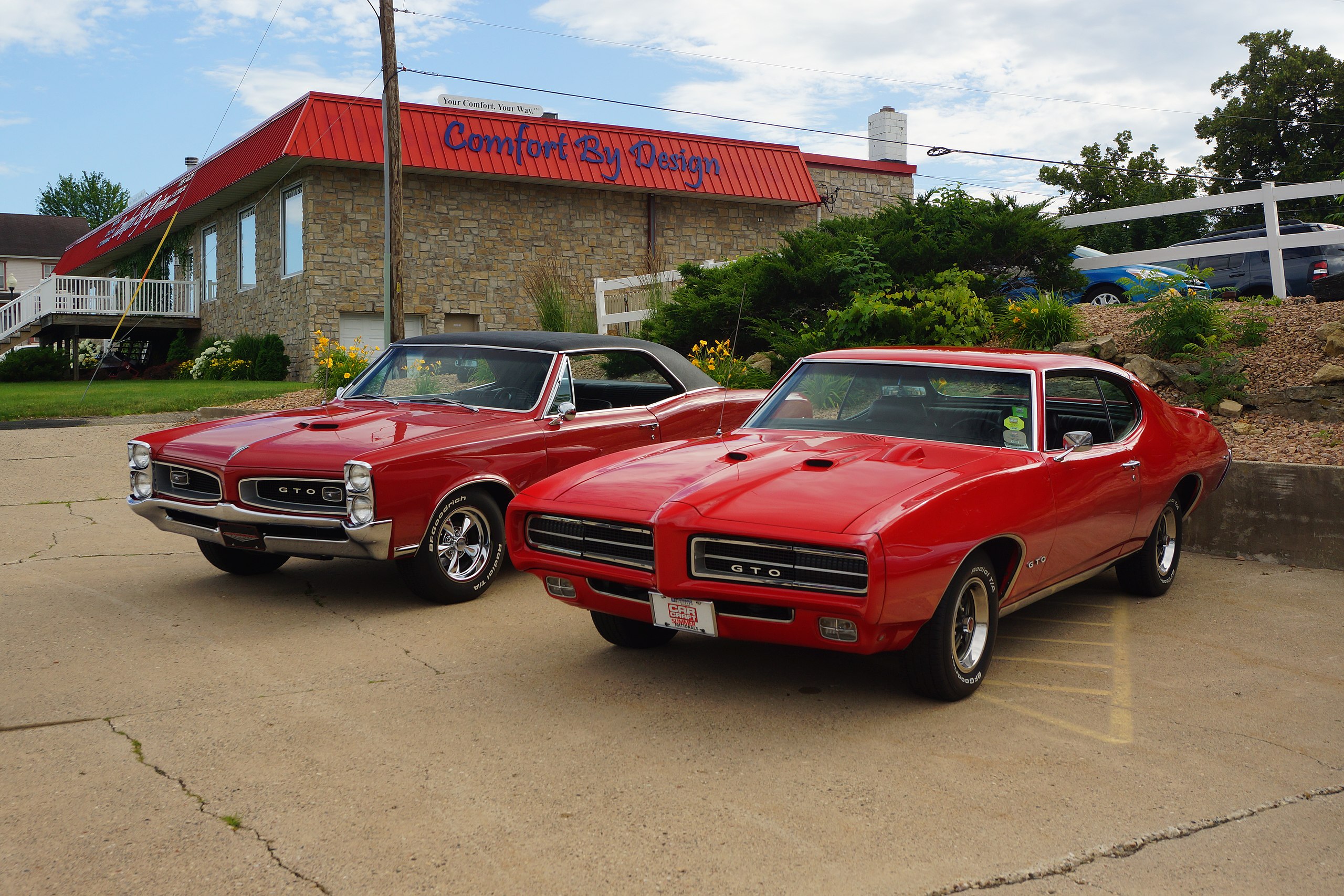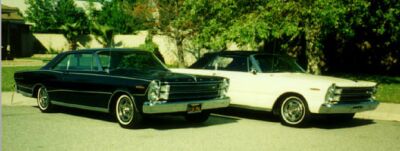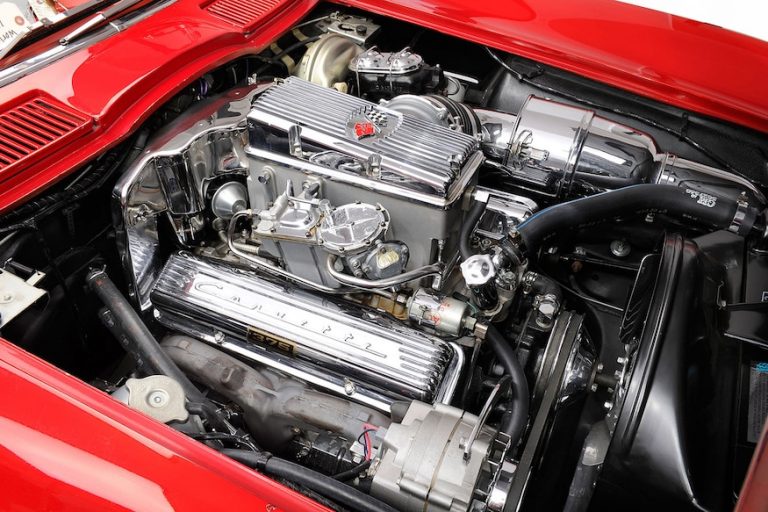Pontiac GTO

Meet Chandler
Chandler has a bachelors and masters degree in history as well as a passion for classics and muscle cars. His education and historical knowledge makes him skilled at crafting highly detailed articles about America’s muscle cars and automotive history. His love of muscle cars is undeniable, with him seeking them out at every opportunity during his visits to auto shows and car meets. Chandler’s knowledge and enthusiasm towards automotive history make him a great asset to the Muscle Car Club community.
Regarded by many as the first true muscle car, the Pontiac GTO stands out today as one of the finest of its era. Pontiac first unveiled the GTO as an options package for the LeMans in 1964, but it soon became its own full fledged model within a few years. By the end of its life in 1974 it would once again revert to an options package, but not before setting America on fire for a few years in the late ‘60s. In its first iteration, the GTO lasted for 11 model years, from 1964–1974.
Today, these are some of the most collectible muscle cars on the market, and well maintained versions of the “Judge GTOs” go for quite the pretty penny. During its heyday, it was powered by massive 389, 400, and 455 cid Pontiac V8s, and the GTO was known for its exceptional performance. It is also well remembered for its iconic styling, including its long hood featuring scoops and the famous GTO badged grille.
In 2004, after it had been in hibernation for 30 years, General Motors once again dusted off the GTO moniker and put it on a rebadged version of the Australian Holden Monaro for the American market. It only lasted for three years until 2006, when the Monaro was also canceled. Pontiac collapsed in 2010, meaning the possibility of the GTO returning again is unfortunately pretty much nil.
Pontiac GTO Overview
The Pontiac GTO spanned a total of 14 model years throughout 5 different generations. The first generation lasted from 1964–1967, and for the first two years was only available as an option package for the Tempest LeMans. Beginning in 1966, the Pontiac GTO became a separate model, where it would stay until 1972 when it again reverted to an option package. For the first generation, the Pontiac GTO could be had in either a coupe, hardtop, or convertible body styles.
The second generation of the Pontiac GTO was the longest, lasting from 1968–1972. This saw the GTO move to the A-body platform, the same platform as the Chevrolet Chevelle and Oldsmobile 4-4-2. The engines got bigger and slightly more powerful, and in 1969 Pontiac unveiled the “Judge” option for the GTO. The Judge GTOs had special performance and aero options, and lasted until the 1971 model year.
The third and fourth generations of the Pontiac GTO lasted for one year each, in 1973 and 1974, respectively. By this point, power was emasculated due to a variety of factors, including emissions restrictions and the switch from SAE Gross to SAE Net horsepower and torque ratings.
The original GTO ended after 1974, at which point it had only one engine making only 200 horsepower. This was a far cry from the 389 cid V8 from the first generation at 325–360 horsepower, or the 400 and 455 cid V8s from the second generation making up to 370 horsepower (all SAE Gross).
Pontiac briefly resurrected the GTO for three years in the early 2000s for the American market as a rebadged Holden Monaro. Lasting only from 2004–2006, the GTO has been dormant since.
How The GTO Was Born
For many people, the muscle car era truly began in 1964 when Pontiac first released the GTO as an option package for the Tempest LeMans. The GTO was conceived by Semon “Bunkie” Knudsen and a team of Pontiac engineers, including John DeLorean – who would go on to build the famous DMC DeLorean in the ‘80s. In the 1950s, Pontiac had successfully rebuilt their image as being more performance based, and started competing against Ford and others in the NASCAR and NHRA racing series.
However, in 1963, General Motors decided to institute a ban on all of their subsidiary divisions, including Pontiac, prohibiting them from engaging in auto racing. In addition, GM also stopped Pontiac from advertising the cars as performance monsters ready for the track. In response, Pontiac engineers led by Knudsen and Delorean developed the Grand Turismo Omologato (GTO) package for the Tempest LeMans.
Knudsen, Delorean, and others – including Bill Collins and Russ Gee – created the GTO while spending time at the Milford Proving Ground. They removed the 326 V8 from a ‘64 Lemans, and replaced it with the larger displacement but same-sized 389 V8. The result was glorious, but the engineers had a problem: how to get the new GTO option into production.
They had to circumvent the ban on high performance marketing, as well as GM’s policy that mandated that every car needed 10 pounds of vehicle per cubic inch of displacement. To get around this, the engineers made the GTO an option package, because the policy only applied to the base engine in each vehicle. Thus, the GTO was born in September 1963, to be made available for the 1964 model year as a Tempest LeMans option.
First Generation Pontiac GTO
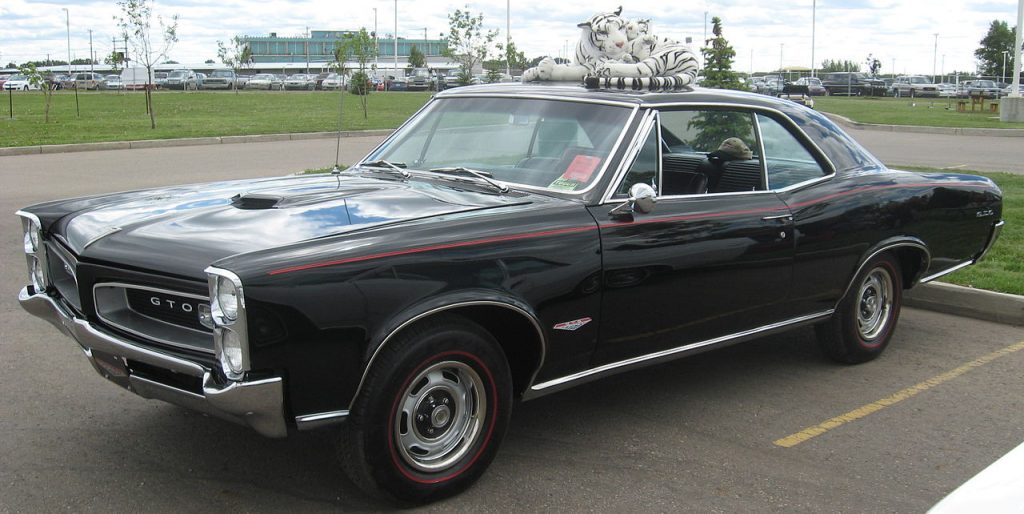
The first generation of the Pontiac GTO lasted from 1964–1967. In addition to the larger 389 V8, the original LeMans GTO package also included shock absorbers, a revised cooling system, dual exhausts, new wheels and tires, stiffer springs and longer rear stabilizers. In 1966, Pontiac made the GTO a standalone model for the first time.
The first generation GTO could be had with three body styles – coupe, hardtop, or convertible. For 1966, the GTO had wide wheel openings, a split mesh-style grille, and smooth curves, giving rise to the “coke bottle” bodystyle nickname. Nicknamed the GOAT, the GTO also revised the interior in 1966, adding nicer trim and bucket seats.
First Generation Engine Technical Specifications
| Model Years | Engine | Horsepower | Torque |
| 1964 | 389 cid V8 (4bbl) | 325 horsepower | 428 lb-ft |
| 1964 | 389 cid V8 (Tri-Power) | 348 horsepower | 428 lb-ft |
| 1965—1966 | 389 cid V8 (44bl) | 335 horsepower | 431 lb-ft |
| 1965—1966 | 389 cid V8 (Tri-Power) | 360 horsepower | 424 lb-ft |
| 1966 | 389 cid V8 (Tri-Power XS) | 360 horsepower | 424 lb-ft |
| 1967 | 400 cid V8 (2bbl) | 255 horsepower | 397 lb-ft |
| 1967 | 400 cid V8 (4bbl) | 335 horsepower | 441 lb-ft |
| 1967 | 400 cid V8 (HO, Ram Air I) | 360 horsepower | 438 lb-ft |
First Generation Engines and Performance
For the inaugural 1964 Pontiac GTO option package there were two engine choices: A small-journal 389 cid V8 with either a single four-barrel Carter 4-V or a Tri-Power carb. The Tri-Power was three Rochester 2CG double-barrels put together to create a massive six-barrel carburetor. The four-barrel 389 made 325 horsepower, while the Tri-Power upped performance to 348 horsepower.
The GTO version of the 389 had a new camshaft and used cylinder heads from the large-journal 421 V8. For 1965–1966, Pontiac increased the four-barrel to 335 horsepower and the Tri-Power to 360 horsepower. Compression on the 389 was 10.75:1, and the Tri-Power added a new 288 degree camshaft.
In 1966, Pontiac introduced a performance option for the GTO known as the “XS” package. This took the Tri-Power 389 and swapped the 288 cam for the high-duration “744” camshaft, as well as stronger valve springs and dampers. Power output was still officially rated at 360 horsepower, though most people thought it made much more.
In 1967, Pontiac ditched the 389 V8 for the slightly larger and more powerful 400 cid V8. There were three power outputs available, an economy version at 255 horsepower, the base at 335 horsepower, and the Ram Air at 360 horsepower. The 400 Ram Air used a Rochester Quadrajet carb and the 744 camshaft from the 1966 XS package. The base V8 also got the Quadrajet, while the economy used a two-barrel Carter AFB.
At first, the Tri-Powered 389 could go from zero to 60 mph in 6 seconds and run the quarter mile in about 14.5 seconds @ 102 mph. As years went on things got faster, and by 1967 the Ram Air GTO could do zero to 60 mph in 5 seconds while hitting the quarter mile in 14.1 seconds at 102 mph.
First Generation Transmissions
For the first two years, available transmissions were an optional two-speed automatic, the standard three-speed Hurst-Campbell manual, or an optional four-speed manual with synchros. In 1967, the new three-speed automatic Turbo-Hydramatic TH-400 replaced the previous two-speed automatic.
Also in 1967, a new Hurst dual-gate shifter was also introduced. The Hurst shifter had a “His and Hers” pattern, which enabled either manual (his) or automatic (hers) shifting. It was introduced as a compromise for couples who could not agree on a single transmission. Hurst provided a special “His Only” key, which allowed for the manual shifter to be locked out to “prevent use of the competition gate by the curious parking lot attendant or automatic minded little lady.”
First Generation Pontiac GTO Production Numbers
| Model Year | Bodystyle | Production Total |
| 1964 | Coupe | 7,384 |
| Hardtop | 18,422 | |
| Convertible | 6,644 | |
| 1964 Total | 32,450 | |
| 1965 | Coupe | 8,319 |
| Hardtop | 55,722 | |
| Convertible | 11,311 | |
| 1965 Total | 75,352 | |
| 1966 | Coupe | 10,363 |
| Hardtop | 73,785 | |
| Convertible | 12,798 | |
| 1966 Total | 96,946 | |
| 1967 | Coupe | 7,029 |
| Hardtop | 65,176 | |
| Convertible | 9,517 | |
| 1967 Total | 81,722 |
The 1964 GTO option vastly exceeded sales by more than six times the estimate, and more than doubled the next year in 1965. This prompted Pontiac to make it a standalone model in 1966, and they were rewarded with another 20,000 jump in sales for the year. The nearly 97,000 GTOs sold in 1966 was the high water mark for the car, which would see a 15,000 drop in production just the next year.
Second Generation Pontiac GTO

The second generation of the Pontiac GTO lasted from 1968–1972 and saw the GTO at its very best. For the 1968 Pontiac GTO, General Motors refined the A-body platform it resided on, resulting in a new fastback-esque design. The wheelbase was smaller at 112” and the new “Endura” paint-matched rubber bumper made its debut. Also new was a dual-scooped hood, dual exhausts, optional hidden headlights, and hidden windshield wipers.
For 1969, the vent windows were removed and the grille was slightly changed, but the real story was the introduction of the “Judge” option package for the GTO. The Judge got its name from Rowan and Martin’s “Laugh In” TV show, which had skits known as “Here Comes da Judge.” Car and Driver called the 1969 Judge GTO a “econo racer,” and that’s exactly what it was. Muscle car performance at economy prices, similar to the Plymouth Road Runner, its main competitor. It wasn’t any cheaper than the standard GTO, but it performed better.
The Judge package included a blacked out radiator, new wheels, functional hood-scoops, and of course, the obligatory Judge and Ram Air decals on the front fenders and scoops. The rear had a floating deck lid spoiler, and it was only available with a Hurst T-handle three-speed manual. The Judge lasted as a package through 1971, after which the GTO once again ceased to be an independent model.
From 1968–1971, the GTO was only made as a hardtop or convertible, with a coupe option being added with the 1972 LeMans bodystyle. The 1970 GTO saw the grille made smaller and flared fenders added in the rear. The hood scoops could be manually controlled by the driver via an under-dash handle, and new heavy duty springs and shock absorbers were standard.
The GTO Becomes an Option Package Again
In 1972, the GTO reverted back to just being a $350 option on the LeMans Sport. The Judge option was gone, and you could no longer buy just a Pontiac GTO by itself. This switch did add the coupe bodystyle, where previously only hardtops and convertibles were available. 1972 marked the beginning of the end for the GTO, as it would be defunct within just a few years.
Second Generation Engine Technical Specifications
| Model Years | Engine | Horsepower | Torque |
| 1968 | 400 cid V8 (2bbl) | 265 horsepower | 397 lb-ft |
| 1968 | 400 cid V8 (HO) | 360 horsepower | 445 lb-ft |
| 1968 | 400 cid V8 (Ram Air II) | 366 horsepower | 445 lb-ft |
| 1968—1970 | 400 cid V8 (4bbl) | 350 horsepower | 445 lb-ft |
| 1969—1970 | 400 cid V8 (Ram Air III) | 366 horsepower | 445 lb-ft |
| 1969—1970 | 400 cid V8 (Ram Air IV) | 370 horsepower | 445 lb-ft |
| 1970 | 455 cid V8 (HO) | 360 horsepower | 500 lb-ft |
| 1971 | 400 cid V8 (4bbl) | 300 horsepower | 400 lb-ft |
| 1971 | 455 cid V8 (4bbl) | 325 horsepower | 455 lb-ft |
| 1971 | 455 cid V8 (HO) | 335 horsepower | 480 lb-ft |
| 1972 | 400 cid V8 (4bbl) | 250 horsepower | 325 lb-ft |
| 1972 | 455 cid V8 (4bbl) | 250 horsepower | 325 lb-ft |
| 1972 | 455 cid V8 (HO) | 300 horsepower | 415 lb-ft |
Second Generation Engines, Transmission Options, and Performance
The 1968 Pontiac GTO retained the same 400 engine as 1967 but with new power figures. The economy engine made 265 horsepower, the base made 350 horsepower, a new high-output (HO) made 360 horsepower, and the Ram Air II made the most at 366 horsepower.
The 1968 Ram Air II was at first the same as the 1967 400 Ram Air (retroactively called the Ram Air I), except those equipped with automatic trans got the lower duration “068” camshaft instead of the 744. Partway through the year, Pontiac added new “96” round-port cylinder heads and replaced the 744/068 cam with the new “041” camshaft. The 041 cam had even more duration and lift than the 744, though stated horsepower didn’t change.
For 1969–1970, Pontiac put the 400 Ram Air III and 400 Ram Air IV inside the GTO, where it made 366 horsepower and 370 horsepower, each. The Ram Air III first used the 744 cam before switching to the 068, and had new heads. For 1969, compression was 10.75:1, which dropped to 10.5:1 in 1970 due to new pistons.
The Ram Air IV used “722” round port heads and the ultra aggressive 041 camshaft. In 1970, the heads changed, which reduced compression to 10.5:1 from the previous 10.75:1. Also in 1970, Pontiac added the large-journal 455 cid V8 as an option, making 360 horsepower and 500 lb-ft of torque with a Rochester Quadrajet carb.
For 1971, the Ram Air options were all dropped, and there were three choices: A 300 horsepower 400 cid V8, a 325 horsepower 455 cid V8, and a 335 horsepower HO 455 V8. The HO 455 had just 8.4:1 compression due to new heads, but still made decent power.
The Change in Power Ratings For 1972
For 1972, the same engine options were retained, but with lower power ratings. Part of this came from detuning due to emissions restrictions and fuel economy concerns, but the larger culprit was mathematical. In 1972, Pontiac switched from SAE Gross to SAE Net power ratings for their cars due to a federal mandate.
SAE Net power ratings are usually lower than SAE Gross ratings, but SAE Net requires the use of mufflers, an air cleaner, and other accessories used in cars that cause a parasitic loss of power. As a result, the 400 cid V8 now only made 250 horsepower, while the 455 V8 could make either 250 horsepower or 300 horsepower in the HO version. Compression also dropped further, now down to 8.2:1.
Second Generation Pontiac GTO Production Numbers
| Model Year | Bodystyle | Production Total |
| 1968 | Hardtop | 77,704 |
| Convertible | 9,980 | |
| 1968 Total | 87,684 | |
| 1969 | Hardtop | 58,126 |
| Convertible | 7,328 | |
| Judge Hardtop | 6,725 | |
| Judge Convertible | 108 | |
| 1969 Total | 72,287 | |
| 1970 | Hardtop | 32,737 |
| Convertible | 3,629 | |
| Judge Hardtop | 3,615 | |
| Judge Convertible | 168 | |
| 1970 Total | 40,149 | |
| 1971 | Hardtop | 9,497 |
| Convertible | 661 | |
| Judge Hardtop | 357 | |
| Judge Convertible | 17 | |
| 1971 Total | 10,532 | |
| 1972 | Coupe | 134 |
| Hardtop | 5,673 | |
| 1972 Total | 5,807 |
For 1968, sales recovered over the prior year slump to make it the second most popular year GTO ever. Unfortunately, it was merely an illusion, as sales started to slip dramatically the next year. Production dropped 15,000 between ‘68–’69, before plummeting another 30,000 in 1970. In 1971, just over 10,000 were sold, with that number being halved the next year when it was reduced to an option package. The GTO just wasn’t selling anymore, at least certainly not enough to justify its own model.
Third and Fourth Generation Pontiac GTO
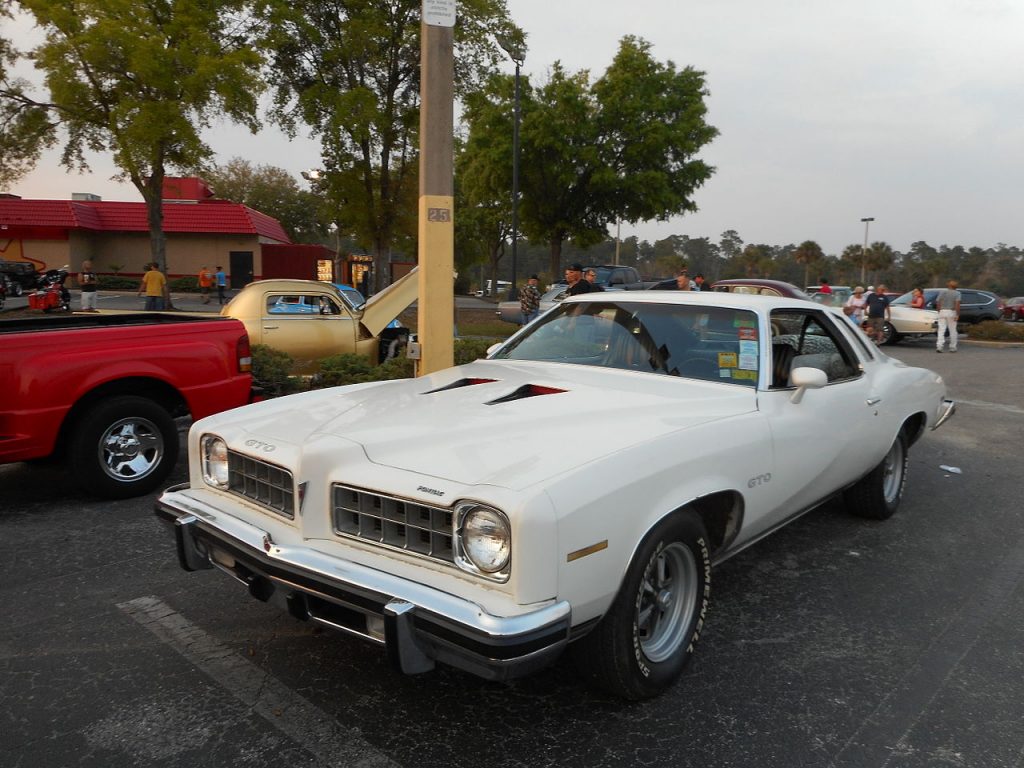
The third and fourth generations of the Pontiac GTO both lasted for one year each. The third generation was the 1973 GTO, while the fourth generation was the 1974 GTO. For 1973, the GTO continued to only be available as an option package for the LeMans or LeMans Sport Colonnade. The 1973 GTO option included a blacked out radiator, dual-scooped hood, bigger tires, and dual exhausts. It did not however have the Endura bumper, which was forced out due to federal regulations.
The 1974 Pontiac GTO, the last year of the original GTOs, was moved from the LeMans to the Pontiac Ventura. For ‘73, the GTO could be had as either a coupe or sport coupe, while in ‘74 a hatchback option was added with the Ventura. 1974 GTO Venturas had a “shaker” hood scoop attached to the engine, which would move or “shake” when under load. Following the 1974 Pontiac GTO, the namesake would take a 30 year nap.
Third and Fourth Generation Engine Technical Specifications
| Model Years | Engine | Horsepower | Torque |
| 1973 | 400 cid V8 (4bbl) | 230 horsepower | 325 lb-ft |
| 1973 | 455 cid V8 (4bbl) | 250 horsepower | 370 lb-ft |
| 1974 | 350 cid V8 (4bbl) | 200 horsepower | 295 lb-ft |
Third and Fourth Generation Engines, Transmission Options, and Performance
For 1973 there were two engine options: A 230 horsepower 400 cid V8 or a 250 horsepower 455 cid V8. The 455 used a four-barrel carb and had a 8.1:1 compression ratio. Performance was much worse for the 400 and 455 than in years prior, and largely turned off buyers.
For the 1974 Pontiac GTO, the only option was a 350 cid V8 making just 200 horsepower. It had a 7.6:1 compression ratio and used a Rochester Quadrajet. Available was a three or four-speed manual transmission, with the four-speed being an additional option. For 1973, a Turbo-Hydramat automatic transmission was available.
Third and Fourth Generation Pontiac GTO Production Numbers
| Model Year | Bodystyle | Production Total |
| 1973 | Coupe | 494 |
| Sport Coupe | 4,312 | |
| 1973 Total | 4,806 | |
| 1974 | Hatchback | 1,723 |
| Coupe | 5,335 | |
| 1974 Total | 7,058 |
By 1973, the GTO was reduced to an option package, and there were just 4,806 total buyers – almost all of them the sport coupe. The ‘74 hatchback helped sales increase slightly for the final version, but it wasn’t enough for Pontiac to keep it around.
Fifth Generation Pontiac GTO

In 1999, Pontiac unveiled the concept GTO for the new generation at that year’s Detroit Auto Show. It featured rounded corners, dual hood-scoops, pinched tail lights, the famous split-grille with a GTO emblem, and was painted a brilliant translucent orange. In hindsight, the concept looks more like a fifth generation Camaro than the GTO it would eventually become in 2004, but it also had some much more futuristic inspired curves.
Following the drop of the Firebird in 2002, Pontiac lacked a high performance model. This was soon rectified by the introduction of the all-new fifth generation GTO in 2004. The new GTO shared the same platform as the Holden Monaro, produced by the GM Australian subsidiary Holden.
However, when Pontiac brought back the GTO they did not give it anything resembling an iconic or unique look. Instead, it just looked like a run of the mill economy car and failed to distinguish itself. While it’s true the original GTO was muscle car performance in a econo car body, the fifth generation was just too conservative to attract much attention.
In 2005, Pontiac made hood scoops standard to help distinguish it as more aggressive, and for many people it was a poor man’s Corvette – just without the visual excitement. The 2006 Pontiac GTO was the last year, as there was little enthusiasm and unjustifiable sales to continue.
Fifth Generation ngine Technical Specifications
| Model Years | Engine | Horsepower | Torque |
| 2004 | LS1 | 350 horsepower | 365 lb-ft |
| 2005—2006 | LS2 | 400 horsepower | 400 lb-ft |
Fifth Generation Engines, Transmission Options, and Performance
While the fifth generation might not have been much to look at, if there is one thing Pontiac did right with it was the engines. For 2004, Pontiac put the LS1 V8 that was sourced from the C5 Corvette. The LS1 is a 5.7L (346 cid) naturally aspirated V8 that makes 350 horsepower.
For 2005–2006, Pontiac replaced the LS1 with the Chevy LS2 from the C6 Corvette. The LS2 is a 6.0L (364 cid) naturally aspirated V8 that makes 400 horsepower. Compression on the LS2 was 10.9:1, up slightly from the 10.2:1 in the LS1.
Each year of the fifth generation GTO was offered with a Borg Warner T-56 manual six-speed transmission. For 2004, the automatic transmission option was the GM 4L60E, which changed to the 4L65E for 2005–2006. Both the 4L60E and 4L65E were four-speeds.
Fifth Generation Pontiac GTO Production Numbers
| Model Year | Transmission | Production Total |
| 2004 | Manual | 8,486 |
| Automatic | 7,254 | |
| 2004 Total | 15,740 | |
| 2005 | Manual | 6,809 |
| Automatic | 4,260 | |
| 2005 Total | 11,069 | |
| 2006 | Manual | 8,764 |
| Automatic | 5,184 | |
| 2006 Total | 13,948 |
The fifth generation GTO was a complete failure for Pontiac/GM. Of an expected 18,000 to be produced, less than 16,000 were sold. Production dropped the next year by more than 4,000, before it saw a slight rebound for 2006. Still, sales were nowhere near what was expected or hoped for, and Pontiac called it quits after just over 40,000 sold over three years.
Pontiac GTO Legacy
Today, the original Pontiac GTO stands out proudly as one of the most iconic and well built muscle cars of its era. Considered by many to be the first true muscle car, the GTO first took on life in 1964 as just an option package for the LeMans Sport. It was made an independent model for 1966, where it would remain until reverting to an option package again in 1972.
In between, Pontiac produced some of the best muscle cars of all time with the GTO, putting inside it massive 389, 400, and 455 cid V8s that made upwards of 370 horsepower and 500 lb-ft of torque. The special “Judge GTOs” from 1969–1971 used the potent Ram Air engines, which combined with upgraded suspension and handling truly made them outstanding vehicles for their time.
After discontinuing the GTO following the 1974 model year, Pontiac brought it back in 2004 as a rebadged Holden Monaro. While it was fantastic from a power perspective, its conservative and lame styling relegated it to a second choice for most buyers, and sales failed to meet expectations. In 2006, Pontiac got rid of the GTO for the final time, and in 2010 Pontiac itself bit the dust.
The GTO is fondly remembered by many as the one of the most special cars Pontiac ever produced, and they are hot items on the collectors market.
*Thanks to Steve Statham’s “Pontiac GTO: Four Decades of Muscle” for various engine specifications.
** Thanks to John Gunnell’s “Standard Catalog of Pontiac” for all production figures and most engine specifications.
*** Thanks to Mark Quitter Racing for all Gen 5 production figures.

